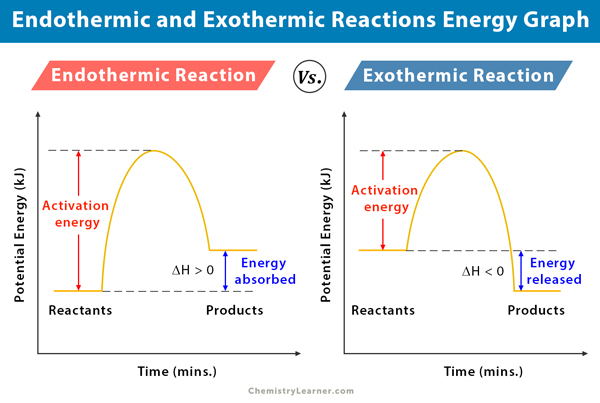A reaction in which heat is absorbed is known as an endothermic reaction. On the basis of.

Endothermic Vs Exothermic Reaction Graphs Youtube
A popular example of an endothermic chemical reaction is photosynthesis.

. Explosion heard when burning hydrogen. Tap again to see term. Therefore the change in enthalpy is negative and heat is released to the surroundings.
Describe the difference between an exothermic and endothermic process in terms of a chemical compound. Tap card to see definition. On the other hand an exothermic reaction releases energy into the surrounding of the system.
A chemical reaction that feels cold endothermic - thermal energy transformed into chemical energy in the products a chemical reaction that feels warm exothermic - thermal energy is released into the surroundings with the products in a chemical reaction dry ice forming fog at a Halloween party. Because the surroundings is gaining heat from the system the temperature of the surroundings increases. Exothermic and Endothermic Processes Describes process of heat exchange and the units of heat.
Photosynthesis evaporation sublimation and melting ice are great examples. Everyday uses of endothermic reactions include instant ice packs which can be used to treat sports injuries. The quantity of heat for a process is represented by the letter.
Chemical reactions that absorb or use energy are called endothermic. The heat changes that occur during a reaction are discussed further below. Endothermic reactions generally involve the formation of chemical bonds through the absorption of heat from the surroundings.
The slideshow describes an exothermic reaction between dilute. Outside describes a process or reaction that releases energy from the system to its surroundings usually in the form of heat but also in a form of light eg. Chemical reactions that release energy are called exothermic.
Exothermic Process definition Click card to see definition. Combustion is an example of an exothermic reaction. An exothermic reaction for example is one in which heat is released.
Energy being removed or leaving a substance. A spark flame or flash electricity eg. The absorbed energy provides the activation energy for the reaction to occur.
A hallmark of this type of reaction is that it feels cold. Exothermic reaction In an exothermic reaction the total energy of the products is less than the total energy of the reactants. You just studied 14 terms.
Definition of Endothermic and Exothermic Reactions The prefixes endo and exo signify inside and outside respectively and thermic is related to. The sign of for an endothermic process is positive because the system is gaining heat. In exothermic reactions more energy is released when the bonds are formed in the products than is used to break the bonds in the reactants.
Chemical reactions that either require energy input to occur or that release energy as a product. The exothermic process describes what happens in an exothermic reaction. An endothermic process absorbs heat and cools the surroundings Based on the above definition lets pick a few examples from our daily lives and categorize them as endothermic or exothermic.
Endothermic and exothermic reactions are chemical reactions that absorb and release heat respectively. An endothermic reaction is any chemical reaction that absorbs heat from its environment. Exothermic reactions are chemical changes that release heat.
Now up your study game with Learn mode. The burning of fuel is an example of a combustion reaction and we as humans rely heavily on this process for our energy requirements. A reaction that is chemical in nature and is characterized by the release of energy in the form of heat or light is called an exothermic reaction.
Describe the difference between an exothermic and endothermic process in terms of a chemical compound or reaction. Chemical reactions that either require energy input to. Exothermic and Endothermic Processes Describes process of heat exchange and the units of heat.
A good example of an endothermic reaction is photosynthesis. A battery or sound eg. In thermodynamics the term exothermic process exo-.
For example when a. The following equations describe the combustion of a hydrocarbon such as petrol textC_8textH_18. Exothermic and endothermic reactions When a chemical reaction occurs energy is transferred to or from the surroundings.
Fuel oxygen heat water carbon dioxide. Endothermic reactions are reactions that require external energy usually in the form of heat for the reaction to proceed. Estimated4 minsto complete Progress Practice Exothermic and Endothermic Processes Practice All Modalities Exothermic and Endothermic Processes.
On the other hand exothermic reactions involve the release of heat energy generated from bond-breakage. A chemical reaction or physical change is exothermic if heat is released by the system into the surroundings. An exothermic process releases heat causing the temperature of the immediate surroundings to rise.
There is usually a temperature change. In simple terms the endothermic reactions absorb energy from the surrounding that is in the form of heat. Click again to see term.
The categorization of a reaction as endo- or exothermic depends on the net heat transfer. Endothermic reactions absorb heat to bring on a chemical change. Compared to an endothermic reaction where energy is absorbed the.
Matching a light using a matchstick is one example of this type of reaction where the release is in the form of both heat and light. During this process plants absorb energy from the. While the reactants prepare to become products they may separate into their individual components.
Combustion and oxidation are the more common examples of this.

What Are Endothermic Reactions With Examples Video

Exothermic And Endothermic Processes Chemistry For Non Majors

Endothermic Reaction Definition Equation Graph Examples

Difference Between Endothermic And Exothermic Reactions Chemistry
0 Comments